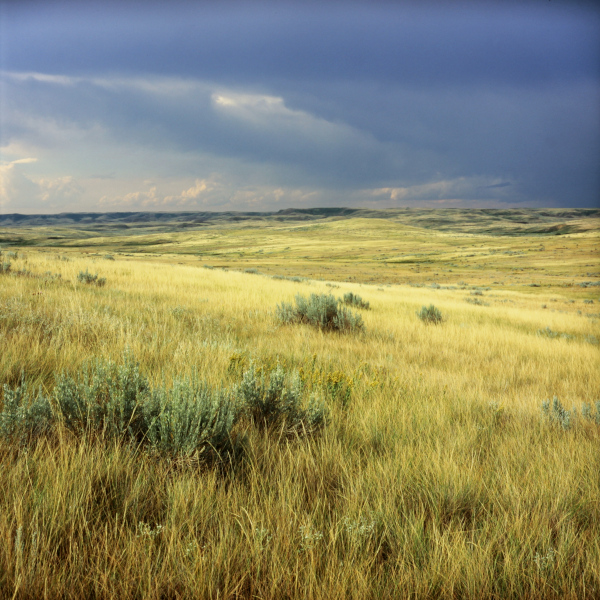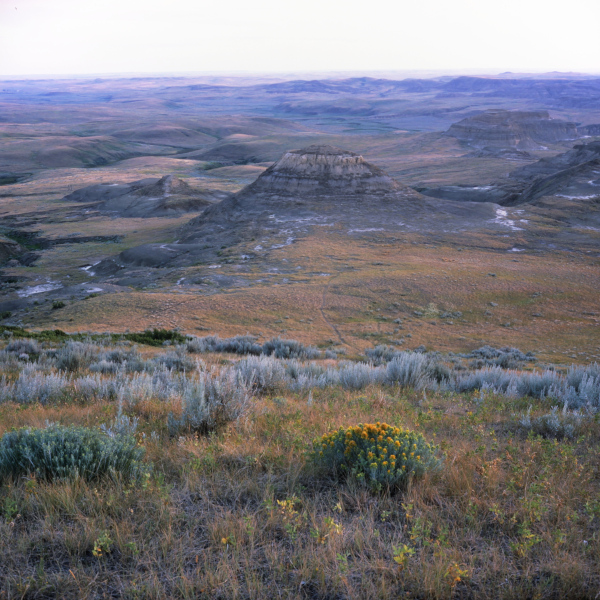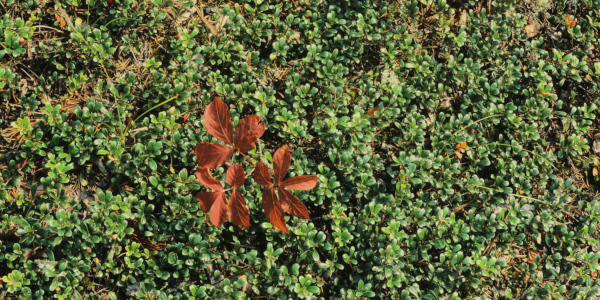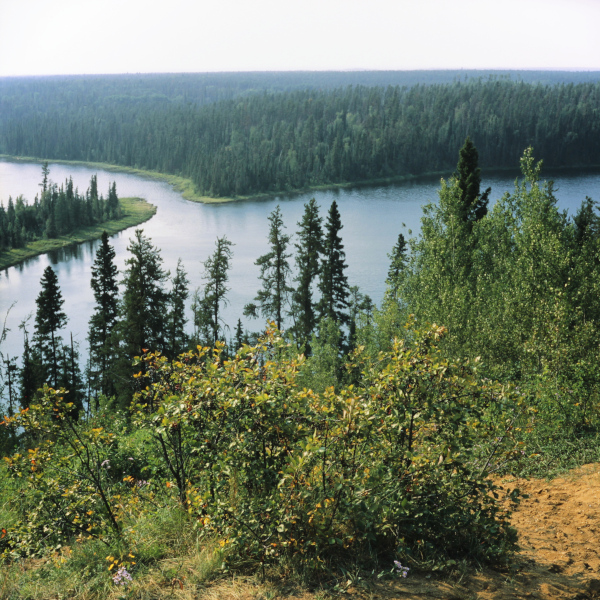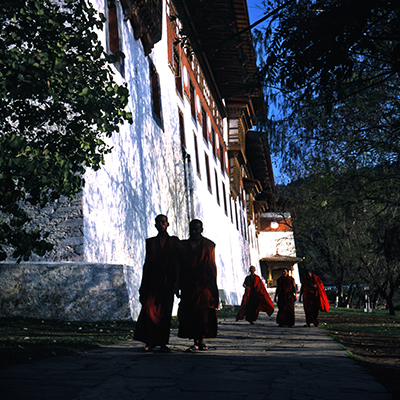 As we walked over the main bridge to the Dzong, a small crowd of monks were walking up a path towards us. Knowing full well that this was a good opportunity to capture them, I ran ahead of my group, as the lighting was nice and dramatic. Happily, I managed to snap a couple shots off before they walked past. What’s great about Bhutan is the sheer beauty and photo-ops at every corner. Unfortunately, you must be accompanied during your entire stay in Bhutan, government rules. Luckily however, it’s a great way to see the country since your guide and driver are always at your beck and call, are extremely knowledgable, and are always striving for you to have a great experience no matter what. If you see a photo op on the side of the road, they will gladly stop! We had them stop actually quite often. We are not used to being ‘pampered’ on our trips, and in fact we are usually quite uncomfortable and ‘unguided’ most of the time, since we tend to travel on a budget. However, Bhutan was an exception for us and since we had no choice but to have a guide, we embraced it with loving arms! If you’re even remotely interested in visiting Bhutan, please message me and I will gladly give you all the details. Shot on my Sputnik, with Fuji Provia 100F film.
As we walked over the main bridge to the Dzong, a small crowd of monks were walking up a path towards us. Knowing full well that this was a good opportunity to capture them, I ran ahead of my group, as the lighting was nice and dramatic. Happily, I managed to snap a couple shots off before they walked past. What’s great about Bhutan is the sheer beauty and photo-ops at every corner. Unfortunately, you must be accompanied during your entire stay in Bhutan, government rules. Luckily however, it’s a great way to see the country since your guide and driver are always at your beck and call, are extremely knowledgable, and are always striving for you to have a great experience no matter what. If you see a photo op on the side of the road, they will gladly stop! We had them stop actually quite often. We are not used to being ‘pampered’ on our trips, and in fact we are usually quite uncomfortable and ‘unguided’ most of the time, since we tend to travel on a budget. However, Bhutan was an exception for us and since we had no choice but to have a guide, we embraced it with loving arms! If you’re even remotely interested in visiting Bhutan, please message me and I will gladly give you all the details. Shot on my Sputnik, with Fuji Provia 100F film.
Punakha Dzong Entrance, Punakha, Bhutan
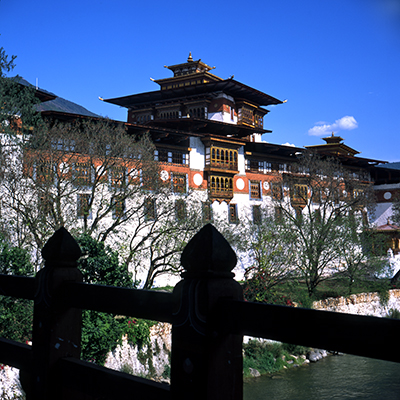 The Punhaka Dzong is the second oldest and the second largest Dzong in Bhutan, and arguably the most impressive. It’s surrounded by a converging river, which adds to it’s splendor. Dzongs used to be fortresses during wartime, but now are used for government offices and a religious monastery. My favorite view of the Dzong is from the bridge leading over the river to the main entrance. This was a more crowded part of Bhutan, mainly because it was closer to the west side of the country, where most tourists tend to gravitate to. This Dzong was by no means, an exception. Due to this, I had to ‘nudge and dodge’ my way over to the railing to get the shot. This was taken with my Sputnik, on Provia 100F film.
The Punhaka Dzong is the second oldest and the second largest Dzong in Bhutan, and arguably the most impressive. It’s surrounded by a converging river, which adds to it’s splendor. Dzongs used to be fortresses during wartime, but now are used for government offices and a religious monastery. My favorite view of the Dzong is from the bridge leading over the river to the main entrance. This was a more crowded part of Bhutan, mainly because it was closer to the west side of the country, where most tourists tend to gravitate to. This Dzong was by no means, an exception. Due to this, I had to ‘nudge and dodge’ my way over to the railing to get the shot. This was taken with my Sputnik, on Provia 100F film.
Chendebji Chorten, Trongsa, Bhutan
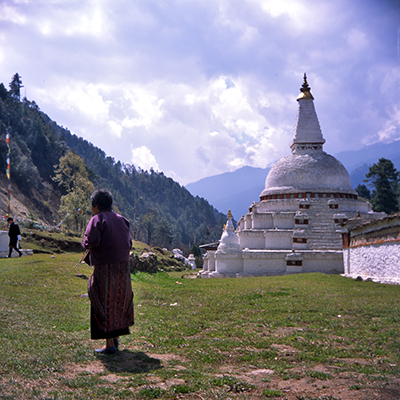
There are a plethora of temples and monasteries in Bhutan, but this Chorten is unusual, even for Bhutan. Dedicated to protect Bhutan’s people from evil spirits, it was built along the same framework as the Bouddhanath Stupa in Nepal. When we arrived, we were alone except for one lone woman who was walking the grounds, praying. We slowly took our time crossing the field, while I tried to get the perfect shot of the Chorten with the full 3D effect. Luckily, the woman decided to make her way over to us, and I got this shot. Unfortunately my Sputnik wasn’t performing well on this trip and was mostly due to my left lens being out of focus. However, this shot was acceptable to me. In the background on the left, you can see our guide, making his prayer rounds at another nearby smaller temple. Shot this on Fuji Provia 100F film.
4 From Don Lopp
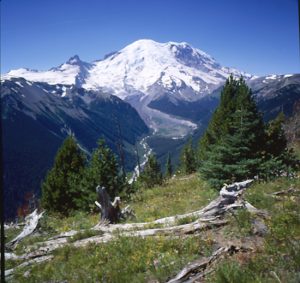
View of Mt Rainer
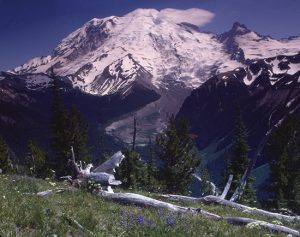
View of Mt Rainer
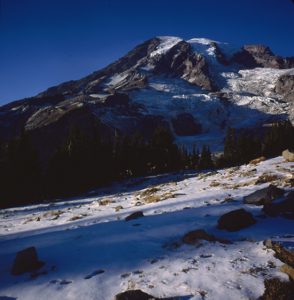
View of Mt Rainer
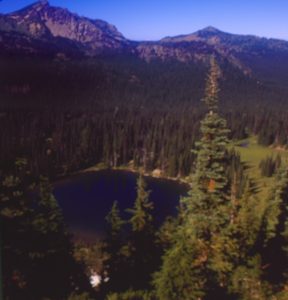
View of Lake from a Mountain Trail
Independence Day Fireworks 2-4
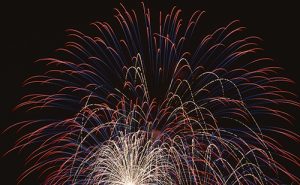
Independence Day fireworks over Seattle’s Lake Union
Taken with twin Hasselblad 500Cs spaced 40 feet apart and triggered with an ingenious device created by my good friend James Baker. The photo is taken from James’ roof. There will be no public fireworks show in Seattle in the year of 2020. But next time I shoot them I expect to be able to trigger the cameras wirelessly, using motorized film winders. Looking forward to that!
Rockwood Farm Entrance 3-3
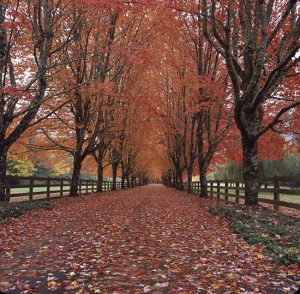
Entrance to Rockwood Farm in Snoqualmie, Washington
Seattle Skyline from Jose Rizal Bridge
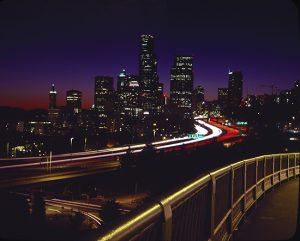
Seattle Skyline from the Jose Rizal Bridge
I’m including this photo because I think it demonstrates a point about composition and fusion. The rail on the bridge is too close in the image, but It works because the line of trees behind it have turned to featureless black and have separated the railing from most of the rest of the shot. I didn’t do that intentionally. I’m not that smart! (There is a small stretch of road that meets the railing that you can see in one image and not the other). The point is that the darkness of the trees act as a separator making it like 2 photographs — the close railing and the far city, so it’s not so difficult to fuse. If there had been a close vertical element (like a tall signpost) that passed through both the near and far parts of the image it couldn’t have worked.
Some notes about this image: The Jose Rizal Bridge is a favorite spot for photographers, and you can imagine why. You need a long exposure to get traffic trails, but the bridge bounces horribly when the frequent buses pass by, so you need to time your shots to avoid them. The image suffers from lens flare that could have been avoided had I been more attentive. And the railing is painted with the ugliest of insitutional green paint, but under the vapor streetlights it looks like solid gold!
Edison In Repose
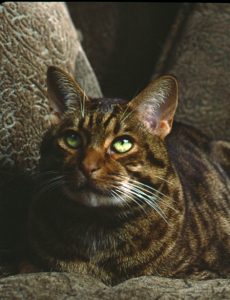
Our cat Edison abiding on a comfy chair.
I do plan to continue this pursuit, but it will involve rebuilding the macro box to accommodate two motorized Hasselblads that can be triggered wirelessly
This was shot with flashes. I’ve mentioned before that I’m a fan of the strobist blog. If you are interested in learning about using portable flash units, go there and start with Lighting 101. I can’t recommend it enough.
I like the eyes and whiskers of course but I especially love the hairs in Eddie’s ears. They remind me of fireworks trails.
Mammoth Creek, CA
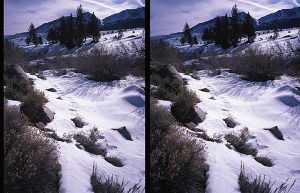
Stepping into the snowed over creek is a bit of a challenge when doing cha-cha hand held stereo as my footing was wobbly and I was unsure if I was keeping alignment between the first frame exposed and the second. Alas, I liked this image enough to include it in this round.
If you’re in Mammoth, have a fun adventure on the loop
https://www.mammothtrails.org/trail/30/town-loop/
Mammoth Creek Roadside, CA
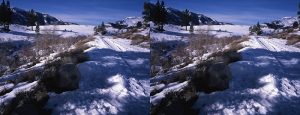
The Town Loop is 7.8 mi and a great run/hike. On the nature part of the loop is the Mammoth Creek and it is beautiful when snowed over, as seen from this roadside view which parallels the trail. Most people just ski during the winter, but hiking and running are fun too. The loop provides a family-friendly tour of town with access to a variety of outbound trails and staging areas. Mammoth Creek Park is a popular start point from which you can tour the eastern half of Mammoth–offering sweeping views of the Sherwins and connections to local schools, the library and dining/shopping–or the western portion, which cruises sleepily through Old Mammoth and past the Valentine Reserve to Eagle Lodge before turning into a quiet neighborhood on its way back out to the Main Street frontage road.
Mammoth Historic Knight Wheel
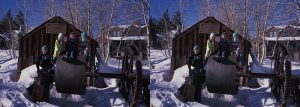
My kids loved climbing up on this.
Gold was discovered in the vicinity of Old Mammoth in 1877 and thousands of men rapidly flocked to the region in the hopes of striking it rich. Today, evidence of these industrious pioneers remains throughout Old Mammoth and no object is able to tell the story of Mammoth’s early history better than the historic Knight water wheel.
The photogenic Knight water wheel, located along Old Mammoth Road, is a preserved remnant of Mammoth Lakes’ industrial beginnings. Now positioned in the quaking aspen adjacent to the paved bike path, this cast iron water wheel has a row of spoon-shaped buckets (Pelton-style) and was a technological marvel in its time. This innovative turbine design allowed late 19th-century industry to generate more power with less water. Previous water wheel designs were inefficient, cumbersome, and required sources providing high volumes of water.
Due to the design’s practicality, Mammoth’s Knight water wheel has a very unique history. The wheel was originally manufactured by the Knight Foundry, located in Sutter Creek, California, in the mid-1870’s and was hauled from the Mojave area to the Mammoth Lakes Basin by mule and oxen team.
Mammoth Mtn Bike Path Bridge
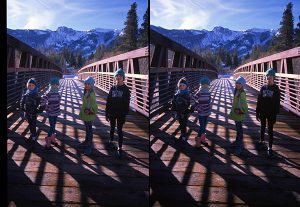
Did some skiing this winter up at Mammoth Mountain with the family and got them to do a morning run with me. Along the adventure we crossed this bridge located just to the North of Old Mammoth Road up and to the end of Waterford Ave. Sometimes the kids would stay still enough to get a cha-cha. My trusty Fuji GA645w is the only light enough MF camera I can take on an adventure hike/run, but you have to do cha-chas, hoping the left and right images are still enough to give the stereo illusion without retinal rivalry.
Ian Andvaag d22 submission
My first two images were taken in the East Block of Grasslands National Park in my home province of Saskatchewan, just North of the US border. It’s one of my favourite parks to visit. Since there are almost no trees (just a few cottonwoods down by the river), you can see a really long way. Consequently, you’re likely to see a lot of wildlife if you visit the park: pronghorn antelope, white-tailed deer, prairie dogs, badgers, ferruginous hawks and all manner of songbirds. Perhaps the most interesting is the burrowing owl, which makes its home in abandoned prairie dog tunnels. There’s also a herd of bison that they reintroduced to the park as a range land management strategy: the bison graze heavily on certain species of grasses, helping to keep a well-balanced prairie.
There are no well-defined trails, so you are free to roam around how you like. There are not many visitors to the park, so you can really appreciate the surroundings and get lost in your own thoughts. Even though you can see quite far, there’s little worry about someone walking into the scene you’re photographing. A lot of people, particularly from rural areas of the province find it strange to “go camping in a pasture”, but it’s really a wonderful place to unplug from fast-paced life and just walk around and think about things. The (mostly) native vegetation and abundance of wildlife is also considerably different to a cultivated pasture. It’s hard to imagine that the entire lower half of this province was filled with native grasslands like these, before 90% of it was cultivated.
There was a pretty big storm the one day I went hiking, and as the lightning was getting closer, I realized how little cover there really was around me on the bald prairie. I rushed down to the bottom of a hill and crouched down to make myself small. There were some tremendously loud and bright lightning strikes nearby which were pretty scary. I felt pretty powerless. The Great Plains image was taken about half an hour later, after the storm had started to move on.
For Badland Butte, I wish I would have had a stereo rig that allowed me to increase the stereo base. I tried some cha-chas with the TL-120, but the angle of the shadows actually changed appreciably in between the exposures, leading to some somewhat unpleasant retinal rivalry. I’m fixing up a couple of Agfa Isolettes; hopefully I’ll have them ready to go for this summer. I’d love to hear anybody’s suggestions for a good slide bar. I found out that Jasper Engineering no longer makes their slide bars.
The last two images were taken in Narrow Hills Provincial Park, this time further North, but still in my home province of Saskatchewan. I really liked the subsurface scattering in the red Sarsaparilla leaves, and the background texture of small green Lingonberry leaves made for a nice detail shot. The Chokecherries image is from the top of an esker left when the glacier retreated. A trail runs along the top of the esker which overlooks several small lakes below. The lakes pictured here are called the Grace Lakes. I visited during the end of summer, so it got pretty cool at night.
Hope you enjoy! Thanks for all your submissions, I really had a great time viewing all the wonderful slides this time around!
Ian Andvaag
“Paper Or Plastic?”
I had my slides all mounted and ready to ship a week ago. They had been titled, scanned, and fit into (seamed) sleeves. The problem was, they wouldn’t fit into the Dragon Folio box. It was then I noticed that every other slide in the box was mounted in cardboard. Mine were in plastic mounts. Instead of remounting my original four, I decided to save them for the next loop of Folio A. I mounted four new selections, all in cardboard mounts;
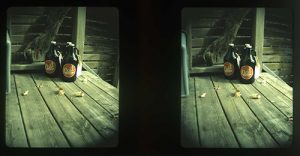
“Same As Surly Curs” – the title is a crossword puzzle type of clue (the answer is “growlers”). This was shot during what is possibly the least-known photography celebration; “World Toy Camera Day”, observed on the third Saturday of October. I employed a Holga 120 CF stereo camera with add-on wide angle lens attachments (which add vignetting) and a roll of Provia 400 to shoot a few photos on my deck to honour the occasion. Developed in a Jobo processor in my basement using Tetenal Colortec E6 chemicals.
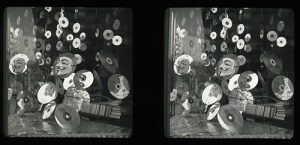
“DISC-guises” – this image is one I originally considered a focal point failure, but I revisited it, mounted the chips and decided to submit it anyways. It was shot with a TL-120-1 on APX 100 film, and sent to dr5 for Dev1 processing.
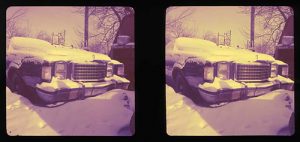
“How To Winterize Your Vehicle” – I’m fairly certain that this was captured on one of a handful of trips to Mclean’s Auto Wreckers in Rockwood. When I feel the urge to go explore this vast car graveyard, I call ahead, then I bake something with beer for the Mclean’s proprietors to gain my admission – chocolate stout cake, raspberry beer blaster cookies….you get the idea. It’s either bake them something beforehand or share your photos with them afterwards, and sharing photos is just too much damned work! Shot with a TL-120-1 on Fuji NHP 400 negative film, then cross-processed in Argentix (Arista) E6 chemicals using a Jobo processor in my basement.
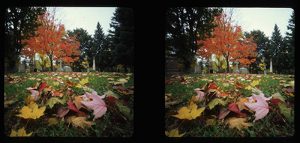
“The Jazz Standard” – this title is also a crossword puzzle type of clue (the answer is “Autumn Leaves”). This is a pinhole image, and I captured this just prior to Hallowe’en 2018, using one of Todd Schlemmer’s terraPIN Oskar^2 stereo pinhole cameras on a GorillaPod. I seem to recall that the exposure was somewhere around the 1 min. 32 sec mark. Todd’s cameras are 3D printed using environmentally-responsible materials. This roll of Fuji RVP was developed in a Jobo processor in my basement using Tetenal Colortec E6 chemicals.
Bazaans MF A0204 (glamour challenged)
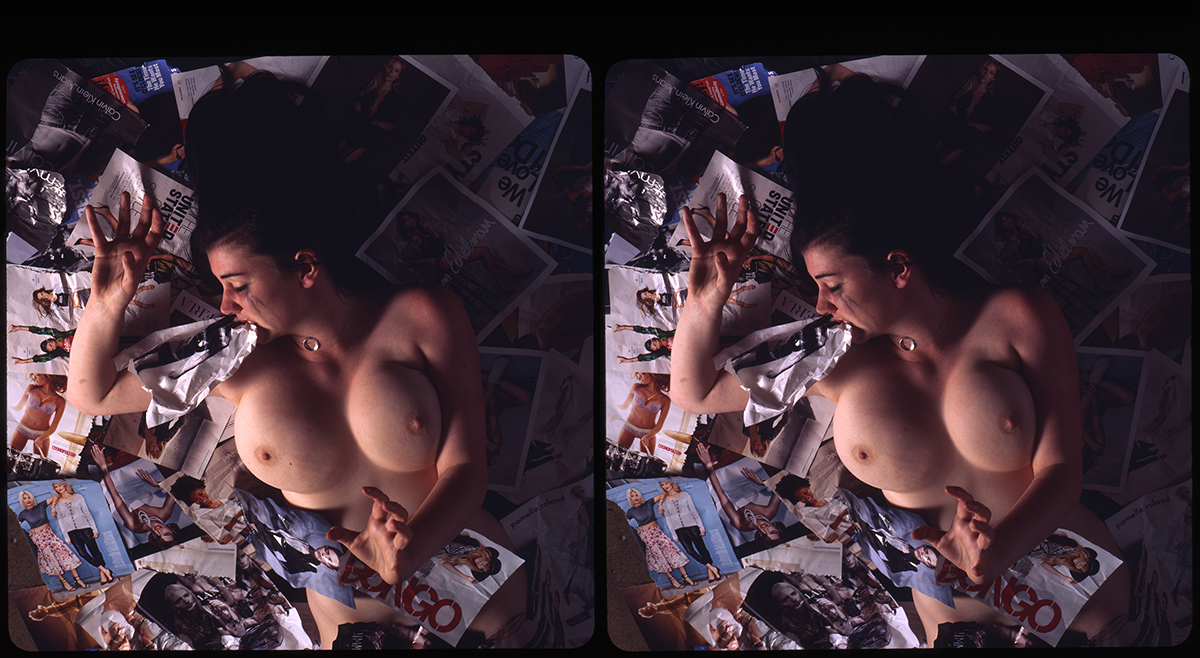
With this image, we are trying to convey the model’s struggles trying to stay afloat in an ocean of popular media glamour imagery, which features predominantly thin women. Bazaans has a “Rubenesque” figure, so her self-image is constantly challenged as being inadequate. What is she doing there? Is she vomiting some of the published pop glamour imagery? I need your help: let me know if you can figure out what it all means.
This was shot in studio with strobes, I think with my “old” Sputnik.
